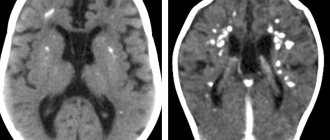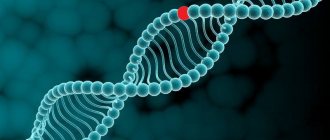Serotonin syndrome (serotonin intoxication) is a rare but potentially fatal reaction of the body to taking medications or drugs that increase serotonergic transmission. It can occur as a result of poisonings, medications (most commonly with antidepressants), an adverse reaction to a combination of medications or drugs, or the recreational use of certain drugs. It often occurs when two or more drugs are used - for example, the combination of SSRI and MAOI antidepressants leads, according to some data, to serotonin syndrome in almost half of patients.
Clinical picture
The clinical manifestations of serotonin syndrome include symptoms of three groups: mental, autonomic and neuromuscular disorders.
Changes in mental status: agitation, anxiety, delirium, euphoria, mania, hallucinations, confusion, mutism, coma.
Symptoms of autonomic dysfunction: abdominal pain, diarrhea, hyperthermia (from 37-38 ° C to 42 ° C and above), headaches, lacrimation, dilated pupils, nausea, tachycardia, tachypnea, fluctuations in blood pressure, chills, increased sweating.
Neuromuscular disorders: akathisia, bilateral Babinski's sign, epileptiform seizures, hyperreflexia, incoordination, myoclonus, horizontal and vertical nystagmus, oculogyric crises, opisthotonus, paresthesia, muscle rigidity, tremor.
At the initial stage, serotonin syndrome manifests itself mainly from the gastrointestinal nervous system: dyspeptic symptoms are characteristic (seething, abdominal cramps, flatulence, loose stools, nausea, less often vomiting, etc.); extrapyramidal disorders (tremor, dysarthria, restlessness, muscle hypertonicity), hyperreflexia, myoclonic twitching, usually starting in the feet and spreading throughout the body.
As the condition worsens, a patient with serotonin syndrome develops a manic-like state, manifested by racing thoughts, accelerated slurred speech, sleep disturbances, hyperactivity, and less commonly, confusion and symptoms of disorientation. At its last stage, with an extremely rarely observed malignant variant of the course (possible with a combination of SSRIs and MAOIs), serotonin syndrome is close to the clinical picture of neuroleptic malignant syndrome: a sharp increase in temperature, profuse sweating, a mask-like face, greasiness of the face, as well as acute cardiovascular disorders which can be fatal.
Dangerous complications of serotonin syndrome also include disseminated intravascular coagulation syndrome, rhabdomyolysis, myoglobinuria, renal, hepatic and multiorgan failure, metabolic acidosis, leukopenia, thrombocytopenia, and tonic-clonic convulsions. Myoclonus affecting the pectoral muscles can also lead to death due to asphyxia or hypoxia.
Cheese mood
Figure 1. Two steps in the synthesis of serotonin from tryptophan. First, an OH group is attached to the amino acid, and then the carboxyl radical is detached. (www.nature.com)
I have previously written about what dopamine does in our brain [1]. Now we will talk about another neurotransmitter - serotonin. As with dopamine, the precursor to serotonin is the amino acid tryptophan. Tryptophan contains an aromatic indole ring, and the compound itself is synthesized in a rather complex way. Serotonin (5-hydroxytryptamine, 5-HT) is obtained from tryptophan in just two reactions: first, a hydroxyl radical is added to the indole moiety, and then a carboxyl group is cleaved from the resulting molecule (Fig. 1).
The distribution pattern of serotonin neuron processes resembles the dopamine system. From the deep parts of the brain - from a complex of clusters of neurons called raphe nuclei - signals scatter throughout almost the entire organ (Fig. 2). Already in place, serotonin interacts with receptors on the postsynaptic membrane, carrying out its psychophysiological effects. There are seven main types of serotonin receptors and many subtypes [2], but describing their roles in detail would take too much space.
Figure 2. Serotonin and dopamine pathways in the human brain. Dopamine fibers from the deep parts of the brain spread to the subcortical regions and the frontal lobe. The processes of serotonin neurons spread more widely and affect a greater number of functions. Drawing from Wikipedia (English).
It is better to pay attention to how the content of tryptophan, a precursor to serotonin, can affect our behavior. It is logical to assume that increasing the amount of tryptophan in food will lead to an increase in serotonin levels. With depression, the content of serotonin in the central nervous system decreases. One can imagine such an experiment: tryptophan is excluded from the human diet. As a result, serotonin synthesis suffers, and we experience a decrease in mood - a typical symptom of depression. In practice it works a little differently. With a decrease in the intake of tryptophan from food, a decrease in mood is observed only in those people who previously suffered from depression [3]. Tryptophan withdrawal did not have a significant effect on subjects without a history of depressive episodes. This appears to be due to altered pathways of serotonin metabolism in patients with depressive disorders that are not present in healthy people.
Interestingly, if tryptophan levels in food are high, it can lead to generosity. A study by Dutch psychologists [4] revealed just such a connection. Subjects who took a higher dose of tryptophan donated more money than subjects who did not receive it. The researchers themselves attribute increased generosity to the connection between the serotonin and oxytocin systems in the brain. A nonspecific increase in signal intensity in the serotonin system leads to an increase in the activity of all structures associated with it. Oxytocin neurons are no exception, and more oxytocin appears in the brain. This increase causes the human brain to become more predisposed to making choices in favor of other people. By the way, cheese is the leader in tryptophan content among food products, and it would be interesting to trace the relationship between cheese consumption and generosity among different nations.
Pathophysiology
Serotonin syndrome is based on excessive activity of central serotonergic structures: predominantly postsynaptic 5-HT1A receptors, but its development is also facilitated by stimulation of 5-HT2 receptors due to the accumulation of serotonin in the synapse. There is also evidence that hyperactivation of noradrenergic structures may also play a critical role in the occurrence of serotonin syndrome. The role of other neurotransmitters is significantly less: glutamate and GABA; The influence of dopaminergic structures on the pathogenesis of serotonin syndrome is also detected, due to pharmacodynamic interactions, direct interaction between serotonergic and dopaminergic structures, or in connection with other mechanisms.
Mechanism of development when taking antidepressants
Serotonin is a neurotransmitter that regulates human behavior or emotional state. The most important function of this active biological substance is considered to be the transmission of impulses between body cells and the brain or between neurons. It suppresses the activity of negative emotions and controls them.
Other functions of serotonin include:
- decreased pain threshold;
- increased blood clotting;
- blood clot formation in areas with open wounds;
- controlling the process of bronchial relaxation;
- ensuring proper rest during sleep;
- regulation of vascular tone;
- eliminating the feeling of nausea;
- improvement of thermoregulation;
- stimulation of active and cognitive activity;
- maintaining normal libido in both males and females;
- positive impact on reproduction;
- preservation of long-term memory;
- regulation of gastric motility and intestinal motility;
- appetite control;
- ensuring an adequate perception of the world.
The amount of serotonin is regulated by the return of the substance, the enzymes responsible for its breakdown, and the brain using feedback. Due to an excess of serotonin in the body, all processes in which it is involved are disrupted. Initially, the development of the disease will affect the synaptic cleft.
This is the space located between the membranes of neurons. It will be filled with a large amount of serotonin, which will lead to overexcitation of serotonin receptors. High levels of serotonin will also stop the breakdown enzymes from working and interfere with the return of the substance.
Prevalence
In 2002, the US Toxicity Screening System compiled data on 26,733 SSRI prescriptions, which resulted in serious toxic effects in 7,349 people, including 93 deaths. Finding out exact epidemiological data on the prevalence of serotonin syndrome is difficult due to the fact that about 85% of doctors are unfamiliar with this pathology and therefore rarely make this diagnosis.
Serotonin syndrome often occurs in elderly patients, children and even infants. It has also been found that it occurs in 14-16% of people with an SSRI overdose.
Serotonin syndrome - what is it?
Serotonin syndrome is a rare but potentially fatal complication of medications that affect serotonin metabolism and increase serotonergic transmission. Serotonin syndrome is also called serotonin toxicity.
In addition to medications, the development of serotonin syndrome can be caused by taking narcotic drugs.
Serotonin syndrome develops due to excessive accumulation of serotonin molecules in synaptic clefts (the space between neuron membranes) and excessive excitation of serotonin receptors on neuronal membranes.
Symptoms of classic serotonin syndrome include:
- mental disorders;
- vegetative manifestations;
- neuromuscular disorders.
Serotonin syndrome can develop at any age. The incidence of serotonin syndrome also does not depend on gender.
Diagnostics
There are no specific laboratory tests, the data of which could be used in the diagnosis of serotonin syndrome; laboratory tests are important only for diagnosing complications (metabolic acidosis, disseminated intravascular coagulation syndrome, rhabdomyolysis) and monitoring the patient. Determining the concentrations of serotonergic drugs in the blood plasma does not play a significant role, since in most cases of serotonin syndrome they do not exceed the permissible level, and their presence in toxic concentrations is not a prerequisite for its development.
Sternbach proposed the following criteria for diagnosing serotonin syndrome:
- At least 3 of the following symptoms are associated with the initiation of therapy with a serotonergic drug, or an increase in its dose, or the addition of another serotonergic drug: agitation, hyperreflexia, diarrhea, increased sweating, mental status changes (confusion, hypomania), fever, myoclonus, disturbances coordination, tremendous chills, tremors.
- Other possible causes have been excluded - infections, metabolic disorders, drug intoxication, withdrawal syndrome, etc.
- Immediately before the onset of symptoms, the patient was not prescribed an antipsychotic drug or, if previously prescribed, its dose was not increased.
Differential diagnosis
Differential diagnosis of serotonin syndrome must be carried out with such conditions as neuroleptic malignant syndrome, malignant hyperthermia, febrile schizophrenia, anticholinergic delirium, acute psychosis, somatic symptoms of depression, heat stroke, meningitis, encephalitis, hyperthyroidism, hypertensive crisis, septicemia, “rigid man” syndrome , tetanus, various intoxications (anticholinergics, amphetamines, lithium, LSD, cocaine, MAOIs, phencyclidine, salicylates, strychnine, sympathomimetics).
Serotonin syndrome - causes
Serotonin syndrome is a dose-dependent complication. That is, the likelihood of the syndrome occurring depends on the dose of the drug taken, as well as on the compatibility of the drugs taken.
In adults, serotonin syndrome develops while taking medications that affect serotonin metabolism, when taking too large doses of these drugs (or when using them for a long time), when switching from one serotonergic drug to another.
For reference. A newborn may develop serotonin syndrome if his mother took drugs that affect serotonin metabolism in the last trimester of pregnancy.
Most often, serotonin syndrome develops due to the use of:
- SSRIs (selective serotonin reuptake inhibitors);
- MAOIs (monoamine oxidase inhibitors);
- combinations of SSRI + MAOI antidepressants (the most severe serotonin syndrome develops);
- combinations of MAOIs with clomipramine.
Serotonin syndrome can also develop due to drug use.
Causes and prevention
The main principle of prevention: limit the use of serotonergic drugs in combination therapy and carefully monitor the patient's condition during its use. It is also necessary to monitor the patient's condition during periods when a new drug is included in the regimen or the dose is increased. In particular, the combination of MAOIs and SSRIs, MAOIs and clomipramine should be avoided. One of the principles of prevention is also compliance with the recommended dosages and regimen of taking antidepressants.
A break of at least two weeks is required:
- in the interval between the abolition of fluoxetine (Prozac) and the appointment of an SSRI;
- between discontinuation of SSRIs and administration of other serotonergic agents;
- between discontinuation of SSRIs and administration of MAOIs.
An interval of at least five weeks is required between the discontinuation of fluoxetine and the appointment of an irreversible MAOI, for elderly patients - at least eight.
When transferring from irreversible MAOIs to SSRIs, a break of four weeks should be maintained (according to other sources - two weeks); When switching from moclobemide to SSRIs, 24 hours is sufficient.
After treatment with clomipramine, you must wait three weeks before prescribing other serotonergic drugs.
The duration of the withdrawal period depends on the length of the half-lives of the drugs. The withdrawal period is at least five half-lives, but this is the minimum recommended withdrawal period. The long half-life of fluoxetine and its main active metabolite, norfluoxetine, may pose significant challenges to clinical use.
In addition, serotonin syndrome has been observed:
- when taking SSRIs or MAOIs together with cold medications containing dextromethorphan, which can inhibit serotonin reuptake, SSRIs or MAOIs with meperidine, tramadol, with nefazodone, with herbal antidepressant drugs containing St. John's wort, with 5-hydroxytryptophan and tryptophan;
- co-administration of SSRIs with opioid analgesics, S-adenosylmethionine (SAM, heptral), metoclopramide, trazodone, clomipramine, amitriptyline, buspirone, anti-migraine drugs, levodopa;
- combined use of MAOIs with cyclic antidepressants, venlafaxine, specific serotonergic antidepressants, methylenedioxymethamphetamine (MDMA, “ecstasy”);
- combined use of the following antidepressants: imipramine and moclobemide, trazodone and fluoxetine, trazodone and buspirone, venlafaxine and tranylcypromine, venlafaxine and phenelzine, fluoxetine and selegiline (at high doses of selegiline - over 10 mg/day);
- combined use of an antidepressant and mood stabilizer: SSRI and carbamazepine, SSRI and lithium, MAOI and lithium;
- co-administration of SSRIs and drugs that affect the metabolism of SSRIs (inhibiting CYP2D6 and CYP3A4 isoforms of cytochrome P450);
- co-administration of tramadol and antidepressants of many groups (including SSRIs).
There are isolated reports of the occurrence of serotonin syndrome during monotherapy with SSRIs (at the beginning of treatment, with a sharp increase in dosage, or during intoxication), as well as during monotherapy with clomipramine or trazodone.
Serotonin syndrome is also possible when taking opioid analgesics, cough suppressants, antibiotics, weight loss drugs, antiemetics, migraine drugs, etc.
The role of serotonin receptors in the motor-evacuation function of the gastrointestinal tract
The main classes of receptors involved in the regulation of motor-evacuation function of the gastrointestinal tract (GIT) are cholinergic, adrenergic, dopaminergic, serotonin, motilin and cholecystokinin. Drugs used for depressive and anxiety disorders, panic attacks and other autonomic dysfunctions act on the same receptors that are responsible for the motor-evacuation function of the gastrointestinal tube. Regulation of smooth muscle activity and intestinal motility occurs at several levels. Hormones and neurotransmitters are the dominant components that directly or indirectly affect smooth muscle cells. The postprandial endocrine response includes the production of insulin, neurotensin, cholecystokinin (CCK), gastrin, glucagon-like peptides (GLP-1 and GLP-2), glucose-dependent insulinotropic polypeptide (GIP, formerly known as gastric inhibitory peptide) [1], effect data neurotransmitters and hormones are presented in table. 1. For example, CCA is secreted in the proximal small intestine and directly influences the contraction of gallbladder muscle cells and the neuromediated relaxation of sphincter of Oddi cells, which is mediated through the GIP neuromuscular junction.
In this article, special attention is paid to serotonergic receptors, which are one of the important regulators of intestinal motility. Serotonin, or 5-hydroxytryptamine (5-HT), is a monoamine neurotransmitter that is the main mediator in the physiology of a person’s psychological state and mood, as well as one of the regulators of vascular function and gastrointestinal motility. 5-HT is known to be present in platelets, the gastrointestinal tract, and the central nervous system of humans and animals [2–5]. Serotonin is produced in the human body from the amino acid tryptophan supplied with food - since it is precisely this that is needed for the direct synthesis of serotonin in synapses; the second pathway for the production of serotonin is associated with the supply of glucose with carbohydrate foods, which stimulates the release of insulin into the blood, followed by protein catabolism in tissues, which also leads to an increase in the level of tryptophan in the blood.
Based on biochemical and pharmacological criteria, 5-HT receptors are divided into seven main subtypes, five of which are found in enterochromaffin neurons, enterochromaffin (EC) cells and gastrointestinal smooth muscle: 5-HT1, 5-HT2, 5-HT3, 5 -HT4 and 5-HT7 [6, 7]. About 80% of the total number of 5-HT receptors are located in intestinal Echo cells, where they participate in intestinal motility through several subtypes of 5-HT receptors [8, 9]. With the exception of 5-HT3 receptors, a gated ion channel ligand, all 5-HT receptors bind to G protein receptors, which activate second-cascade intracellular reactions, stimulating excitatory or inhibitory responses in the gastrointestinal tract [10]. Serotonin has well-studied effects on intestinal motility, secretion and sensitivity through central and peripheral neurotransmitter pathways, making it a key pharmacological agent used in the treatment of gastrointestinal motility disorders [11]. Serotonin is released from EC cells in response to chemical or mechanical stimulation of the mucosa [12] or in response to experimental models of stress [13]. Serotonin is synthesized and stored not only in EC cells (90%), but also in intestinal neurons (10%). As mentioned above, 5-HT is released into the blood after eating and in response to changes in pressure in the intestinal wall, as well as when exposed to harmful stimuli [13], and then enters the intestinal lumen and further into its walls from the basolateral depot of ECH cells [14]. 5-HT stimulates the circular and longitudinal muscles of the stomach, duodenum and jejunum [15]. The strategic location of EC cells in close proximity to sensory nerve endings of the intestinal mucosa, interganglionic neurons, and synapses of motor excitatory and inhibitory neurons is important. Serotonin increases the contraction amplitude of the muscles of the stomach, duodenum, jejunum and ileum [16]. In the small intestine, 5-HT stimulates circular muscle contractions during the first manometric phase, the resulting contractions spread, become more frequent and activate fast motor complexes [17]. In the colon, serotonin stimulates motility along the entire length, causing phasic contractions, but not giant motor complexes [18]. Intestinal smooth muscle rhythmic oscillations are determined by the spontaneous activity of interstitial cells of Cajal, which act as a pacemaker for cells in the gastrointestinal tract [19–22]. The enteric nervous system (ENS) consists of semi-autonomous effector systems that are connected to the central autonomic system. When serotonin is released from enterochromaffin cells, vagal reflexes are initiated - peristaltic, excretory, vasodilatory, nociceptive. The parasympathetic and sympathetic divisions of the autonomic nervous system form the CNS through afferent and efferent connections. The ongoing bidirectional relationship of the brain-gut reflex arc involving 5-HT has a significant impact on effector systems. Impaired 5-HT transmission can lead to both intestinal and extraintestinal manifestations of irritable bowel syndrome (IBS) [23].
The degree of participation of various 5-HT in the functional peristaltic activity of the gastrointestinal tract is divided as follows - 5-HT3 - 65%, 5-HT4 - 85% and 5-HT7 - 40%. When combined, antagonists of these receptors, given in pairs, are able to reduce intestinal peristaltic activity by approximately 16% (5-HT3 + 5-HT4), 70% (5-HT3 + 5-HT7) and 87% (5-HT4 + 5-HT7), and the simultaneous administration of all three antagonists inevitably blocks all peristaltic activity. Thus, 5-HT receptors play a key role in modulating intestinal motility by simultaneously blocking three receptors and inhibiting peristaltic activity. Among the 5-HT receptors of the gastrointestinal tract, the 5-HT4 subtype is the most functionally important for peristalsis, and the 5-HT3 and 5-HT7 receptors play a slightly less active role in this process, as reflected in Table. 2 and in Fig. 1 [24].
5-HT4 agonists became available with the introduction of metoclopramide in 1964. This drug is a dopamine D2 and 5-HT3 receptor antagonist and a 5-HT4 receptor agonist and is still widely used throughout the world. Its success has led to the development of alternative molecules that do not affect D2 receptors, thereby eliminating adverse events such as akathisia and extrapyramidal movement disorders.
Serotonin receptors, in particular 5-HT3 and 5-HT4, are involved in sensory and reflex responses to stimuli in gastrointestinal disorders, causing manifestations such as vomiting, constipation or diarrhea, eating disorders, abdominal pain, altered sensorimotor reflexes [25 ]. It has been suggested that selective serotonin reuptake inhibitors (SSRIs) may affect 5-HT3 receptor function and may also improve symptoms of IBS and comorbid depression in patients. According to a number of studies and reviews [26–29], tricyclic antidepressants (amitriptyline, Melipramine), antidepressants of a number of SSRIs, such as fluoxetine, paroxetine, citalopram, clomipramine, litoxetine, trazodone, and a number of selective serotonin and norepinephrine reuptake inhibitors (SSRIs) ( duloxetine) improves IBS symptoms. Long-term side effects of this therapy are common to antidepressant treatment and include anticholinergic, serotonergic, sedative, antihistamine, and alpha-adrenergic effects. These effects must be taken into account when choosing a treatment approach, since the drugs described above affect intestinal motility, the patient's bowel function should also be taken into account when choosing serotonergic drugs (Fig. 2) [30].
As stated previously, the 5-HT1, 5-HT3, and 5-HT4 receptor subtypes play important roles in the motor, sensory, and secretory functions of the gastrointestinal tract. Drugs that directly affect 5-HT receptors, unlike tricyclic antidepressants and SSRIs, modulate 5-hydroxytryptamine (5-HT) by binding to 5-HT receptors; their characteristics are shown in Table. 3. Intestinal functions of 5-HT receptors are associated with smooth muscle, increased bowel movements, and decreased intestinal transit time [31, 32]. Blockade of 5-HT3 receptors, in particular by antiemetics such as ondansetron, leads to constipation [33]. Over the past decade, the 5-HT3 receptor blockers alosetron and silansetron have been developed and tested for IBS-D (IBS with diarrhea). A recent systematic review and meta-analysis of 11 randomized controlled trials (RCTs) comparing these two 5-HT3 antagonists with placebo found a beneficial effect [34]. However, a number of rare side effects, including ischemic colitis and severe constipation, led to the suspension of alosetron production and research on silansetron [35]. Alosetron is currently available only under strict indications (in the US) for patients with severe refractory IBS with diarrhea who have not responded to first or second line therapy.
5-HT4 agonists have proven their therapeutic potential for the treatment of patients with gastrointestinal motility disorders. Drugs that lack selectivity for 5-HT4 receptors have limited clinical success in gastroenterological practice. For example, in addition to their affinity for 5-HT4 receptors, drugs such as cisapride and tegaserod also have marked affinity for other receptors, channels, or transmitter proteins. The adverse cardiovascular events observed with these agents are due to their nonselectivity and crossover effects. A systematic review and meta-analysis found that tegaserod is superior to placebo in the treatment of constipation, including IBS. Most of the studies related to tegaserod were conducted in women, and as a result, the drug was initially approved for the treatment of IBS-C (IBS with constipation) only in women. However, marketing of tegaserod was also suspended when data on a possible increase in cardiovascular and cerebrovascular events with the drug were reported [6].
An important event in clinical pharmacology was the discovery of a selective ligand (ligand, from Latin ligare - to bind, an atom, ion or molecule associated with a certain center (acceptor), the term is used in biochemistry to designate agents that combine with biological acceptors - receptors, immunoglobulins and etc.) to the 5-HT4 receptor - prucalopride. The selectivity of this new drug significantly distinguishes it from older generations of alternative drugs by minimizing the potential for side effects. In addition, the concept of searching for similar ligands opens up broad opportunities for further drug development and the creation of agonist-specific effects in various types of cells, tissues or organs. The selective 5-HT4 receptor agonist prucalopride is an innovative drug with an attractive safety profile for the treatment of patients suffering from hypomotility gastrointestinal disorders [36]. Prucalopride has high affinity and selectivity for 5-HT4 receptors in the gastrointestinal tract. During the existence of the drug prucalopride, several large and long-term studies were conducted, which made it possible to fully evaluate the risks and benefits of using prucalopride for chronic constipation [36–38]. Overall, prucalopride was associated with consistent and significant improvements in patient satisfaction with their treatment, as assessed by the Patient Assessment of Constipation Quality of Life questionnaire (PAC-QOL). The proportion of participants receiving prucalopride 2 mg daily who reported an improvement of ≥ 1 point on the PAC-QOL 5-point subscale was 45.3%, compared with 21.3% of those receiving placebo (p ≤ 0.001), but the response rate in almost all studies was less than 50%. The other trials, PRU-USA-11 and PRU-USA-13, found no significant difference between prucalopride and placebo at all surrogate points. The overall incidence of adverse events was statistically significantly higher in patients receiving prucalopride (72%) compared with patients receiving placebo (59%) (hazard ratio (RR) 1.21, 95% confidence interval (CI): 1.06 , 1.38). The adverse events most commonly reported by patients receiving prucalopride were headache (up to 30%), nausea (up to 24%), diarrhea (up to 5%), abdominal pain and flatulence (up to 23%), dizziness (up to 5 %) and upper respiratory tract infections [39]. R. Cinca et al. compared the effectiveness, safety and impact on quality of life of macrogol and prucalopride in 240 women with chronic constipation for whom other laxatives did not provide adequate relief. In this study, macrogol was more effective than prucalopride for the treatment of chronic constipation and was better tolerated [40]. As a result, we can conclude that prucalopride can be prescribed by a doctor experienced in the treatment of chronic constipation to women from 18 to 75 years of age if other laxatives have not been effective in their treatment.
It is important to know that patients do not always have a deficiency of serotonin; in some cases, the doctor may encounter an excess of it. In restless gastroenterological patients who have elevated serotonin levels, aerophagia develops, which causes an increase in the air bubble in the stomach and leads to irritation of the receptor apparatus [41]. Elevated levels of serotonin cause frequent nausea and vomiting due to activation of the vagus nerve, diarrhea or spastic constipation, gastrointestinal panic attacks, headache, tremor, hyperhidrosis, agitation and anxiety, palpitations, unstable blood pressure, insomnia.
Serotonin plays an important role not only in the regulation of motility and secretion in the gastrointestinal tract, enhancing its peristalsis and secretory activity, but is also a growth factor for some types of symbiotic microorganisms and enhances bacterial metabolism in the colon. The colon bacteria themselves also make some contribution to the intestinal secretion of serotonin, since many species of commensal bacteria have the ability to decarboxylate tryptophan. With dysbiosis and a number of other diseases of the colon, the production of serotonin by the intestines is significantly reduced. The massive release of serotonin from dying cells of the gastric and intestinal mucosa under the influence of cytotoxic chemotherapy is one of the causes of nausea and vomiting, as well as diarrhea during chemotherapy for malignant tumors [42, 43].
It is difficult to overestimate the role of serotonin in the human body. In the front part of the brain, under the influence of serotonin, areas responsible for the process of cognitive activity are stimulated, and an increase in serotonergic activity creates a feeling of uplift in the cerebral cortex. Serotonin entering the spinal cord has a positive effect on motor activity and muscle tone; this state can be characterized by the phrase “I can move mountains.” In addition to mood, serotonin is “responsible” for self-control or emotional stability. Serotonin controls the sensitivity of brain receptors to stress hormones adrenaline and norepinephrine. In people with low serotonin levels, the slightest trigger triggers a massive stress response. Some researchers believe that the dominance of an individual in the social hierarchy is due precisely to the high level of serotonin [42, 43].
Conclusion
When food enters the body, including food containing tryptophan, the production of serotonin increases, which improves mood. The brain quickly grasps the connection between these phenomena and, in the case of depression (serotonin starvation), immediately “demands” additional food intake with tryptophan or glucose. The richest foods in tryptophan are those that consist almost entirely of carbohydrates, for example, bread, bananas, chocolate, figs, dried apricots, dates, raisins, watermelons, etc. The listed products have long been known as regulators of intestinal motility. Their nutritional deficiency leads to depression and gastrointestinal problems, which can often be observed in people following a strict low-calorie diet. For this reason, before prescribing medications to a patient that increase serotonin levels, it is necessary to clarify the cause of its deficiency. Knowledge of the details of the structure of serotonin receptors will undoubtedly find application in treating patients with non-cardiotoxic serotonin analogues or drugs that increase serotonin levels, which will perform their healing function and will be pleasant in all respects, for example, such as chocolate [44]. Drugs that increase the level of serotonin in the synaptic cleft and enhance its effects belong to the group of antidepressants. Today they are among the most prescribed medications by general medical practitioners in many countries around the world, including Europe and North America. Timely prescription of antidepressants, both in monotherapy and in treatment regimens for various diseases, can increase the effectiveness of treatment of the underlying disease and improve the quality of life of patients, especially in gastroenterological patients.
Literature
- Medhus A.W., Sandstad O., Naslund E. at al. The influence of the migrating motor complex on the postprandial endocrine response // Scand J Gastroenterol. 1999. 34. R. 1012–1018.
- Buchheit KH, Engel G., Mutschler E., Richardson B. Study of the contractile effect of 5-hydroxytryptamine (5-HT) in the isolated longitudinal muscle strip from guinea pig ileum. Evidence for two distinct release mechanisms // Naunyn Schmiedebergs Arch Pharmacol. 1985. 329. R. 36–41.
- Kim DY, Camilleri M. Serotonin: a mediator of the brain-gut connection // Am J Gastroenterol. 2000. 95. R. 2698–2709.
- Woollard DJ, Bornstein JC, Furness JB Characterization of 5-HT receptors mediating contraction and relaxation of the longitudinal muscle of the guinea pig distal colon in vitro // Naunyn Schmiedebergs Arch Pharmacol. 1994. 349. R. 455–462.
- Yamano M., Ito H., Miyata K. Species differences in the 5-hydroxytryptamine-induced contraction in the isolated distal ileum // Jpn J Pharmacol. 1997. 74. R. 267–274.
- De Maeyer JH, Lefebvre RA, Schuurkes JA 5-HT4 receptor agonists: similar but not the same // Neurogastroenterol Motil. 2008. 20. R. 99–112.
- Hannon J., Hoyer D. Molecular biology of 5-HT receptors // Behav Brain Res. 2008. 195. R. 198–213.
- Kim DY, Camilleri M. Serotonin: a mediator of the brain-gut connection // Am J Gastroenterol. 2000. 95. R. 2698–2709.
- Berger M., Gray JA, Roth BL The expanded biology of serotonin // Annu Rev Med. 2009. 60. R. 355–366.
- Hannon J., Hoyer D. Molecular biology of 5-HT receptors // Behav Brain Res. 2008. 195. R. 198–213.
- Crowell MD Role of serotonin in the pathophysiology of the irritable bowel syndrome // Br J Pharmacol. 2004. 141. R. 1285–1293.
- Gershon MD Plasticity in serotonin control mechanisms in the gut // Curr Opin Pharmacol. 2003. 3. R. 600–607.
- Bearcroft CP, Perrett D., Farthing MJ Postprandial plasma 5-hydroxytryptamine in diarrhoea predominant irritable bowel syndrome: a pilot study // Gut. 1998. 42. R. 42–46.
- Hansen MB Small intestinal manometry // Physiol Res. 2002. 51. R. 541–556.
- Fishlock DJ, Parks AG, Dewell JV Action of 5-hydroxytryptamine on the human stomach, duodenum, and jejunum in vitro // Gut. 1965. 6. R. 338–342.
- Hopkinson GB, Hinsdale J., Jaffe BM Contraction of canine stomach and small bowel by intravenous administration of serotonin. A physiological response? // Scand J Gastroenterol. 1989. 24. R. 923–932.
- Hansen MB, Gregersen H., Husebye E., Wallin L. Effect of serotonin and ondansetron on upper GI manometry in healthy volunteers // Neurogastroenterol Motil. 2000. 12. R. 281.
- Boerckxstaens GE, Pelckmans PA, Rampart M. at al. Pharmacological characterization of 5-hydroxytryptamine receptors in the canine terminal ileum and ileocolonic junction // J Pharmacol ExpTher. 1990. 254. R. 652–658.
- Alberti E., Mikkelsen HB, Larsen JO, Jimenez M. Motility patterns and distribution of interstitial cells of Cajal and nitrergic neurons in the proximal, mid- and distal-colon of the rat // Neurogastroenterol Motil. 2005. 17. R. 133–147.
- Sanders KM A case for interstitial cells of Cajal as pacemakers and mediators of neurotransmission in the gastrointestinal tract // Gastroenterology. 1996. 111. R. 492–515.
- Thomsen L., Robinson T.L., Lee J.C. at al. Interstitial cells of Cajal generate a rhythmic pacemaker current // Nat Med. 1998. 4. R. 848–851.
- Park SY, Je HD, Shim JH, Sohn UD Characteristics of spontaneous contraction in the circular smooth muscles of cat ileum // Arch Pharm Res. 2010. 33. R. 159–165.
- Crowell MD Role of serotonin in the pathophysiology of the irritable bowel syndrome // Br J Pharmacol. 2004. 141 (8). R. 1285–1293.
- Balestra B., Vicini R., Pastoris O. at al. 5-HT receptors and control of intestinal motility: expression and hierarchical role // Poster Session, Bologna. 2011.
- Read NW, Gwee KA The importance of 5-hydroxytryptamine receptors in the gut // Pharmacol Ther. 1994. Apr-May; 62 (1–2). R. 159–173.
- Lucchelli A., Santagostino-Barbone MG, Barbieri A. at al. The interaction of antidepressant drugs with central and peripheral (enteric) 5-HT3 and 5-HT4 receptors // Br J Pharmacol. 1995. Mar; 114(5). R. 1017–1025.
- Ford AC, Talley NJ, Schoenfeld PS, Quigley EM, Moayyedi P. Efficacy of antidepressants and psychological therapies in irritable bowel syndrome: systematic review and meta-analysis // Gut. 2009. Mar; 58(3). R. 367–378.
- Friedrich M., Grady SE, Wall GC Effects of antidepressants in patients with irritable bowel syndrome and comorbid depression // Clin Ther. 2010. July; 32(7). R. 1221–1233.
- Chial HJ, Camilleri M, Burton D at al. Selective effects of serotonergic psychoactive agents on gastrointestinal functions in health // Am J Physiol Gastrointest Liver Physiol. 2003. 284. G130-G137.
- Turvill JL, Connor P., Farthing MJ The inhibition of cholera toxin-induced 5-HT release by the 5-HT (3) receptor antagonist, granisetron, in the rat // Br J Pharmacol. 2000. 130. R. 1031–1036.
- Ruckebusch Y., Bardon T. Involvement of serotonergic mechanisms in initiation of small intestine cyclic motor events // Dig Dis Sci. 1984. 29. R. 520–527.
- Haus U., Spath M., Farber L. Spectrum of use and tolerability of 5-HT3 receptor antagonists // Scand J Rheumatol Suppl. 2004. 119. R. 12–18.
- Ford AC, Brandt. LJ, Young C. at al. Efficacy of 5-HT3 antagonists and 5-HT4 agonists in irritable bowel syndrome: Systematic review and metaanalysis // Am J Gastroenterol. 2009. 104. R. 1831–1843.
- US Food and Drug Administration. Glaxo Wellcome withdraws irritable bowel syndrome medication // FDA Consum. 2001. 35. R. 3.
- Johanson JF, Drossman DA, Panas R., Wahle A., Ueno R. Clinical trial: phase 2 study of lubiprostone for irritable bowel syndrome with constipation // Aliment. Pharmacol. 2008. 27. R. 685–696.
- Camilleri M., Kerstens R., Rykx A., Vandeplassche L. A Placebo-Controlled Trial of Prucalopride for Severe Chronic Constipation // N Engl J Med. 2008. 358. R. 2344–2354.
- Tack J., van Outryve M., Beyens G., Kerstens R., Vandeplassche L. Prucalopride (Resolor) in the treatment of severe chronic constipation in patients dissatisfied with laxatives // Gut. 2009; 58: 357–565.
- Quigley E.M., Vandeplassche L., Kerstens R., Ausma J. Clinical trial: the efficacy, impact on quality of life, and safety and tolerability of prucalopride in severe chronic constipation a 12-week, randomized, double-blind, placebo-controlled study // Aliment Pharmacol Ther. 2009; 29: 315–328.
- https://www.pbs.gov.au/industry/listing/elements/pbac-meetings/psd/2012–7/prucalopride.pdf.
- Cinca R., Chera D., Gruss HJ, Halphen M. Randomised clinical trial: macrogol/PEG 3350+electrolytes versus prucalopride in the treatment of chronic constipation - a comparison in a controlled environment // Aliment Pharmacol Ther. May 2013; 37(9). R. 876–886.
- Burov N. E. Nausea and vomiting in clinical practice (etiology, pathogenesis, prevention and treatment) // Russian Medical Journal. 2002. No. 16. pp. 390–395.
- Barinov E.F., Sulaeva O.N. The role of serotonin in the physiology and pathology of the gastrointestinal tract // RZHGGK. 2012. T. 21. No. 2. P. 4–13.
- Ashmarin I. P., Eshchenko N. D., Karazeeva E. P. Neurochemistry in tables and diagrams. M.: “Exam”, 2007. 143 p.
- Palczewski K., Kiser PD As good as chocolate // Science. 2013. 340. R. 562–563.
E. Yu. Plotnikova1, Doctor of Medical Sciences, Professor O. A. Krasnov, Doctor of Medical Sciences, Professor
State Budgetary Educational Institution of Higher Professional Education Kemerovo State Medical Academy of the Ministry of Health of the Russian Federation, Kemerovo
1 Contact information
Treatment
No special therapeutic measures have been developed for serotonin syndrome; recommendations regarding its treatment are based on individual case reports. Discontinuation of all serotonergic drugs is the first and main measure for serotonin syndrome, which in most patients leads to a rapid decrease in symptoms within 6-12 hours and to their complete disappearance within 24 hours (in the case of fluoxetine, a more protracted course of several days is possible) .
Other necessary measures are symptomatic therapy and individual care. In severe cases, prescribing serotonin antagonists (cyproheptadine, methysergide); detoxification therapy and other measures aimed at maintaining homeostasis. Paracetamol and external cooling are used to lower body temperature; when body temperature rises to 40.5 C, which indicates a threat to the patient’s life, intensive external cooling, endotracheal intubation with transfer to artificial ventilation and the introduction of muscle relaxants should be used to prevent the occurrence of rhabdomyolysis and disseminated intravascular coagulation. Benzodiazepines (eg, lorazepam) may be used to reduce the muscle rigidity associated with serotonin syndrome and the hyperthermia it often causes. Benzodiazepines can also be used to control agitation; physical restraint should be avoided in serotonin syndrome. For hypertension, direct sympathomimetics in small doses (adrenaline, norepinephrine) are used to maintain normal blood pressure.
The use of propranolol, bromocriptine and dantrolene should be avoided as these drugs may worsen the condition of patients with serotonin syndrome, causing severe side effects and leading to increased mortality. Data regarding the beneficial effects of bromocriptine and dantrolene appear to be the result of misdiagnosis of serotonin syndrome in disorders caused by other causes.
In mild cases (with the presence of hyperreflexia and tremor, but without fever), serotonin syndrome is observed within 24 hours after starting therapy and stopping the drug, but some symptoms may persist for a longer time: this depends on the half-life of the active substance and its active substances. metabolites. Typically, supportive care, including intravenous fluids, vital signs, and benzodiazepines to reduce agitation, is sufficient. However, even such mild patients require supervision due to the possibility of a sudden deterioration in their condition with the need for intensive care.
Main features
Signs of serotonin syndrome (SS) manifest in different ways. Some of those who sought help noticed changes in their well-being within 6 hours after using the incorrect combination of drugs. Other victims felt problems within the first 24 hours. Some patients survived for more than 24 hours.
Until now, no method has been developed to identify the syndrome; only diagnosis based on clinical symptoms is used. But they are too ambiguous, so you need to take into account several signs. Not all patients with symptoms of SS go to the doctor because they do not realize the seriousness of the situation. And not every doctor can identify the syndrome.
It was observed that the simultaneous use of antidepressants and drugs initially leads to an increase in serotonin, and after a day its amount decreases to zero.
Lack of the hormone leads to serotonin failure!
During diagnosis, the doctor takes into account violations in three areas:
- changes at the mental level;
- vegetative symptoms;
- neuromuscular signs.
Mental disorders
The development of pathology affects the patient’s psyche:
- a state of excitement sets in;
- there is anxiety, unconscious fear ending in a panic attack;
- euphoria, joy, a desire to talk without stopping, to grab onto different things, to constantly be on the move sets in;
- consciousness is often impaired;
- severe changes lead to a delusional state complicated by hallucinations.
Sometimes doctors mistake these symptoms for a worsening mental illness and increase the dosage of medications. This further aggravates the patient's condition.
Autonomic symptoms
With an excess of serotonin, symptoms of a vegetative nature are present:
- increased heart rate;
- sudden increase in blood pressure followed by loss of consciousness;
- an increase in the diameter of the pupils, the appearance of lacrimation;
- development of fever, change in temperature (up to 40 degrees);
- increased respiratory rate;
- gastrointestinal problems (diarrhea, vomiting, bloating, colic, pain in the intestines);
- unbearable pain in the head;
- dryness of the mucous membranes of the mouth and nose;
- excessive sweating.
The listed symptoms may indicate numerous diseases. This is the problem with diagnosing SS.
Neuromuscular signs
Serotonin regulates the formation and conduction of nerve impulses in the brain. Changes in hormone levels negatively affect the innervation of muscle fibers. The following symptoms occur:
- increased muscle contraction in the legs, increased reflexes in the tendons;
- increased muscle tone and stiffness;
- spasm of muscle fibers without a specific rhythm at a fast pace;
- tremor of the limbs;
- rapid movements of the eyeballs (nystagmus);
- rolling your eyes up or down;
- lack of coordination in movements;
- spasm of the muscles involved in articulation, hence the slurred words in conversation.
Stages of development and severity of the syndrome
Pathology develops gradually, according to severity it is divided into the following groups:
- Mild – the symptoms are mild and therefore remain unattended. The temperature does not change, slight tremor of the limbs, increased heart rate, increased sweating, slightly dilated pupils. Patients mistake their condition for overwork or the consequences of stress.
- The disease is of moderate severity and is characterized by worsening symptoms. There is a sharp jump in temperature (up to 40 - 42 degrees) and pressure, muscle spasms, and the pupils are constantly dilated. The patient feels agitated. He needs help, but he doesn’t always get it due to the doctor’s incompetence.
- A severe form can result in the death of the patient. All the signs are there, they cause suffering. Patients often fall into a comatose state and experience epileptic seizures. The threat is posed by multiple organ failure associated with muscle breakdown and the development of acidosis.
The disease very quickly passes from one stage to another. Therefore, there is no need to neglect a slight ailment when everything is still fixable.
Providing medical care
In order for the treatment to give a positive result, it is necessary to discontinue all medications that the patient had previously taken.
That is, those that have a negative effect on serotonin metabolism. To ensure that the drugs are completely removed from the body, sorbents are prescribed or gastric lavage is performed. Then the doctor prescribes treatment, which is symptomatic. This is necessary to improve the patient’s condition and restore the body. Next, medications are prescribed to relieve agitation.
Infusion therapy using droppers is also necessary. In order for the autonomic nervous system to be restored, potent drugs are sometimes necessary.
If the patient experiences respiratory failure, as well as at elevated temperatures, a breathing tube is inserted to perform pulmonary ventilation. If the case is extremely severe, then serotonin antagonists are administered.
It is very important to prevent further development of the syndrome, so doctors recommend seeking help in the initial stages of the development of serotonin syndrome. If the symptoms of the disease are not relieved within the first 12 hours, negative consequences are possible.
Here is an approximate scheme of symptomatic treatment of a patient with serotonin syndrome:
- benzodiazepines (Sibazon, Lorazepam) reduce muscle tone and rigidity, relieve mental agitation and epilepsy attacks;
- drugs from the Paracetamol group to reduce body temperature;
- in severe cases, muscle relaxants ;
- intravenous infusions are necessary if there is significant fluid loss.
Mechanical methods in the form of cool rubbing or rubbing with vinegar will also help;
If timely assistance was not provided on time, the following complications may develop:
- renal failure;
- development of coma;
- negative effect on the heart muscle and blood vessels;
- destructive process in muscle tissue;
- acid-base metabolism in the body is disrupted (metabolic acidosis);
- the process of blood clotting is disrupted.
Three stages of development of the syndrome
Serotonin syndrome is divided into three degrees of severity:
- Mild degree . The heart rate is slightly increased, increased sweating and slight tremors in the limbs occur. Body temperature is not elevated, while the pupils are dilated and reflexes are pronounced. Usually, in this condition, patients do not go to doctors, often not connecting these symptoms with taking antidepressants. Therefore, the mild form is rarely diagnosed.
- Moderate severity . The heart rate is significantly increased, intestinal function is disrupted, epigastric pain occurs, and body pressure and temperature are increased. Nystagmus and rolling of the eyeball develops. The mental arousal of a person is already visible, during which reflexes increase, and tremors of the limbs are felt.
- Heavy stage . Here a threat to the patient’s life is already developing. Severe hypertension, tachycardia, hyperthermia, the person begins to delirium, and disorientation in time and space occurs. Severe hallucinations develop. Muscle tone increases, consciousness is impaired, and severe sweating is observed. This is followed by impaired blood clotting, metabolic acidosis and muscle breakdown. The liver and kidneys work at an increased rate, which leads to their failure, possibly the development of multiple organ failure. All these disorders lead to coma. Possible death. Fortunately, a severe degree develops extremely rarely.
Pathogenesis
The cause of the development of serotonin syndrome is serotonin intoxication, caused by the accumulation of serotonin in synaptic clefts while taking serotonergic drugs.
Depending on the mechanism of action of the drug used, six mechanisms for the development of serotonin intoxication are distinguished:
- When taking a serotonergic drug, serotonin synthesis increases.
- The drug stimulates the release of serotonin molecules from the vesicles of presynaptic neurons.
- The drugs act as serotonin agonists.
- The medications taken prevent the reuptake of serotonin molecules by neuronal presynaptic endings.
- Medicines promote rapid sensitization of postsynaptic receptors.
- The medications taken help slow down the metabolism of serotonin molecules and the development of monoamine oxidase deficiency (the enzyme responsible for the breakdown of serotonin).
For reference. The clinical picture of serotonin syndrome is associated with overstimulation of serotonin receptors.
Hyperstimulation of 5-HT1A receptors leads to hyperactivity, anxiety, restlessness, and hyperreflexia.
Overstimulation of 5-HT2A receptors is accompanied by impaired coordination of movements, the appearance of neuromuscular excitation, and febrile symptoms. With excessive stimulation of 5-HT3A receptors, diarrhea, vomiting, nausea, and abdominal pain are observed.









